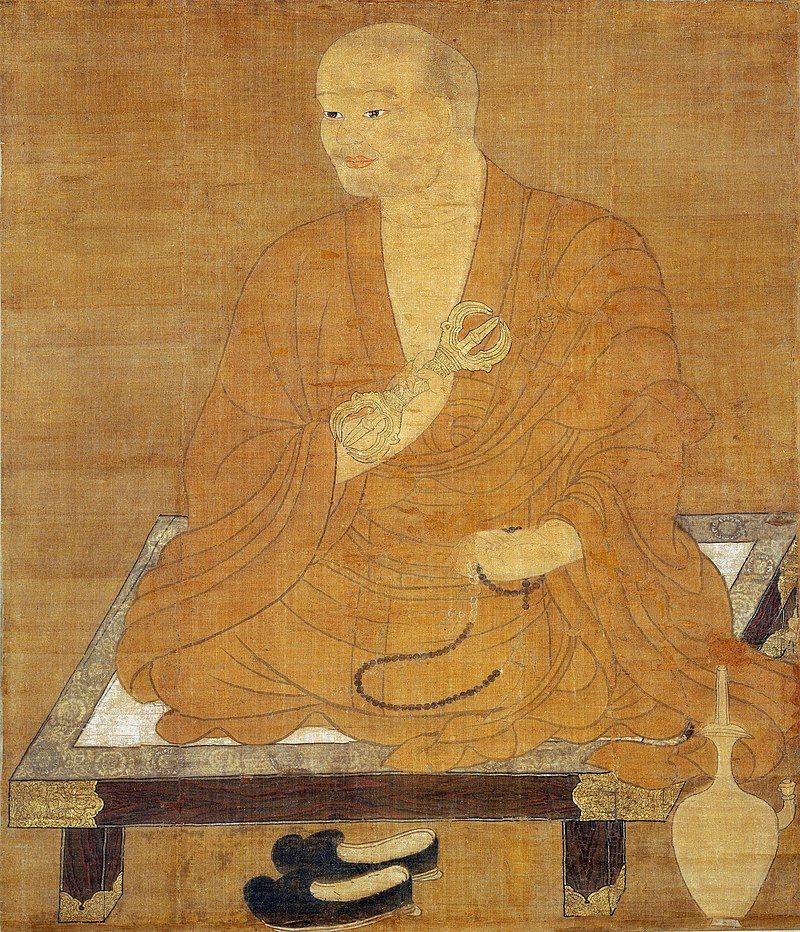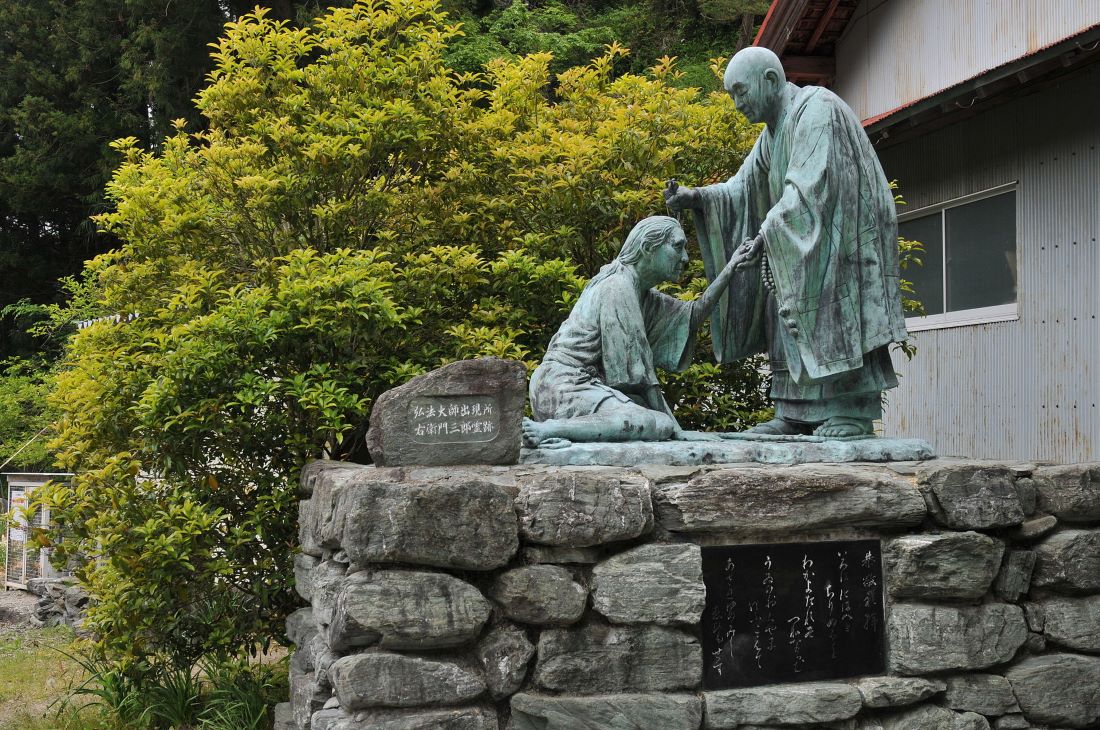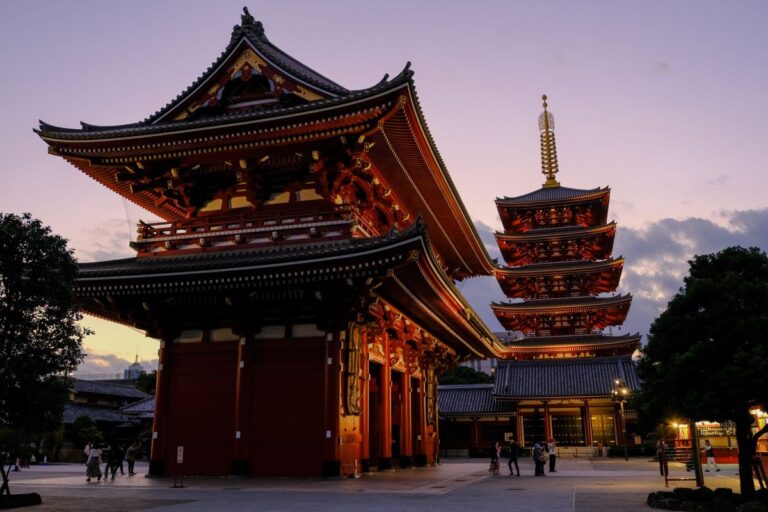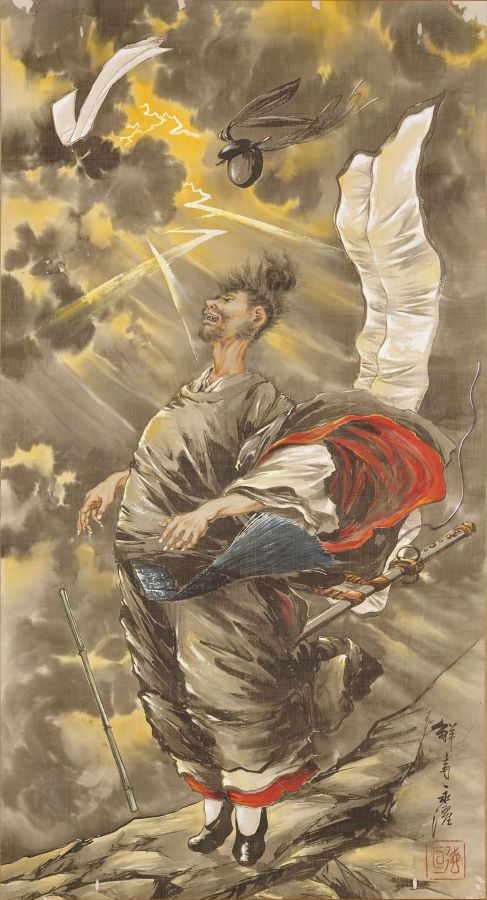Kūkai, also known as Kōbō-Daishi, was a Japanese Buddhist monk, scholar, and artist who lived from 774 to 835. He is revered as one of the most important figures in Japanese Buddhism, and his teachings continue to influence Japanese culture to this day. Kūkai was born into a family of noble lineage and was educated in the Chinese classics from a young age.

At the age of 21, Kūkai became a monk and began studying under several prominent Buddhist masters. He quickly distinguished himself as a brilliant scholar and was eventually sent to China to further his studies. While in China, Kūkai became deeply immersed in the teachings of Esoteric Buddhism, a form of Buddhism that emphasizes the use of mantras, mudras, and other esoteric practices to achieve enlightenment.
Upon returning to Japan, Kūkai founded the Shingon school of Buddhism, which remains one of the major schools of Japanese Buddhism to this day. He also established several temples and monasteries throughout Japan and is credited with introducing many important cultural practices to the country, including calligraphy, poetry, and the tea ceremony. Kūkai’s legacy continues to be felt in Japan and beyond, and his teachings remain a source of inspiration for Buddhists and non-Buddhists alike.
Early Life

Kūkai was born in 774 CE in the Japanese province of Sanuki (now Kagawa Prefecture). His birth name was Mao (真王), and he was the second son of a family of government officials. From an early age, Kūkai showed a strong interest in learning and was known for his intelligence and quick wit.
At the age of fifteen, Kūkai began his formal education at the provincial school, where he studied Confucianism, Chinese literature, and poetry. However, he soon became disillusioned with the limitations of these subjects and began to seek out a deeper understanding of the world.
In 792 CE, Kūkai traveled to the capital city of Nara to continue his studies at the Imperial University. There, he was introduced to the teachings of Buddhism and became fascinated by the religion’s emphasis on enlightenment and the nature of reality. Kūkai soon began to study under the famous monk Saichō, who would become his mentor and guide for many years to come.
Journey to China

Kūkai’s journey to China was a significant turning point in his life. It was a journey that would shape his spiritual beliefs and influence his teachings for the rest of his life.
In 804, Kūkai set out on a journey to China, which was then the center of Buddhism in East Asia. His primary goal was to study Esoteric Buddhism, which was not yet practiced in Japan. After a perilous journey across the sea, Kūkai arrived in China, where he spent several years studying under the guidance of several masters, including Huiguo, who would become his most important teacher.
During his time in China, Kūkai learned the intricacies of Esoteric Buddhism and studied the Sanskrit language, which was essential for understanding its teachings. He also studied Chinese calligraphy and poetry, which would later become an integral part of his teachings.
After several years of intense study, Kūkai was initiated into the lineage of Esoteric Buddhism and given the name Kōbō Daishi. He returned to Japan in 806, where he began to teach Esoteric Buddhism and established the Shingon school of Buddhism.
Overall, Kūkai’s journey to China was a transformative experience that shaped his spiritual beliefs and influenced his teachings. It was a journey that would ultimately have a profound impact on Japanese Buddhism and the country’s cultural heritage.
Founding of Shingon Buddhism

Kūkai, also known as Kōbō-Daishi, founded Shingon Buddhism in Japan during the early 9th century. Shingon Buddhism is a form of esoteric Buddhism that originated in India and was brought to China by the monk Vajrabodhi. Kūkai studied in China and brought the teachings of Shingon Buddhism back to Japan.
Shingon Buddhism emphasizes the use of mantras, mudras, and mandalas to achieve enlightenment. It also places great importance on the idea of the innate Buddha nature in all beings. Kūkai believed that every person had the potential to become a Buddha and that the purpose of Shingon Buddhism was to help individuals awaken to their true nature.
Kūkai’s teachings were initially met with resistance from the established Buddhist schools in Japan. However, he eventually gained the support of the imperial court and was able to establish a temple on Mount Kōya, which became the center of Shingon Buddhism in Japan. Today, Shingon Buddhism remains one of the major schools of Buddhism in Japan and has spread to other parts of the world.
In addition to his role as the founder of Shingon Buddhism, Kūkai was also a prolific writer and artist. He wrote numerous treatises on Buddhism and calligraphy, and his artwork is still highly regarded today. Kūkai’s legacy continues to influence Japanese culture and spirituality, and his teachings are studied by Buddhist practitioners around the world.
Later Life and Legacy

After returning from his travels, Kūkai spent the rest of his life teaching and writing. He continued to attract many students and followers, and his teachings became widely respected throughout Japan.
Kūkai’s most significant legacy is the creation of the Shingon school of Buddhism, which is still practiced today. He also left behind a vast collection of writings, including commentaries on Buddhist texts, poetry, and philosophical treatises.
Throughout his life, Kūkai remained committed to the principles of Buddhism, and his teachings emphasized the importance of compassion, wisdom, and self-awareness. He believed that through meditation and spiritual practice, individuals could achieve enlightenment and transcend the suffering of the world.
Kūkai’s influence on Japanese culture and spirituality cannot be overstated. His teachings and writings continue to inspire people today, and his legacy remains an essential part of Japan’s religious and cultural heritage.



